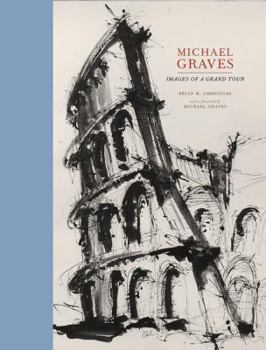Michael Graves: Images of a Tour
Select Format
Select Condition 
Book Overview
In 1960, before his skyscrapers and teapots made him a household name, Michael Graves set out on a journey once considered obligatory for a young architect: a grand tour of the great monuments of Europe. As a recipient of the prestigious Prix de Rome, Graves traveled through Italy, Greece, Turkey, Spain, England, Germany, and France, studying and recording the masterworks of both ancient and modern architecture. Michael Graves: Images of A Grand Tour collects for the first time the stunning artwork produced during this trip. Delicate pencil sketches, striking ink washes, and colorful photographs show the deep connection Graves had to the places he visited, from the Roman Forum to the Grecian Acropolis to Wiltshires Stonehenge. They also tell something of the education of an architect, bringing to light the classical buildings that caused Graves to reexamine his early devotion to modernism. A foreword by Graves reflects on these travels from the distance of forty years, while author Brian Ambroziak puts the tour into the context of Graves's life and work.
Format:Hardcover
Language:English
ISBN:1568985290
ISBN13:9781568985299
Release Date:November 2005
Publisher:Princeton Architectural Press
Length:272 Pages
Weight:2.20 lbs.
Dimensions:1.3" x 7.6" x 9.5"
Age Range:13 years and up
Grade Range:Grade 8 to Postsecondary
Customer Reviews
3 ratings
A View from the Mind of a Master
Published by Thriftbooks.com User , 19 years ago
Here are images drawn by a young man destined to be one of the premier designers of our time. They were done in the 1960-62 time frame when Mr. Graves was a student in Rome. He traveled across Europe sketching, painting and photographing. His subjects were primarily architectural, but also included images that his eye could pull out of a scene that the rest of us would miss. These two years, Mr. Graves says in the Foreward, taught him to experiment with media, style, even places to paint other than in his studio. This was two years of independent graduate study that in part gave him the background to go on to the success that has made him almost a household word. These are fascinating drawings, often showing the essence of a point of design with only a few strokes. The next picture captures what an architect of centuries earlier designed in a Roman structure. Once in a while there's a photograph to capture a particular scene. All in all, a view of what a talented person sees.
A Grand Collection
Published by Thriftbooks.com User , 19 years ago
Prior to creating post-modernist architecture and becoming a household name (thanks to Target), Michael Graves' career took him to the American Academy in Rome from 1960 through 1962. While there, Graves immersed himself in the architecture of Rome, Italy, Greece, Turkey, France, Spain, and the United Kingdom which have been collected into a book aptly entitled "Michael Graves: Images of a Grand Tour". The drawings within "Images if a Grand Tour" are grand themselves as they vary from quick pencil sketches to elaborate pen and ink sketches of full building perspectives, details, and partial cityscapes. All of the drawings exhume a certain elegance in their composition and mannerism despite the level of time and detail Graves may have paid to them. Two important lessons can be drawn from the collection of Graves drawings. The first is that the importance of drawing to the representation of architecture - be it built or conceived - is unparalleled. The drawings contain gestures of ideas, form, etc. that Graves was highly interested in. This point is further reinforced with the inclusion of Graves' writing entitled "The Necessity for Drawing". The second lesson that can be observed from this collection is the emergence of Michael Graves as an Architect. Graves' noted architectural style evolves with his studies during those two years, and one can begin to see many of the forms and shapes arise from what Graves is immersed in. Whether or not one may love or loathe the work of Michael Graves, "Images of a Grand Tour" is a superb collection of drawings that are worthy of note and worthy of owning.
The Necessity For Seeing
Published by Thriftbooks.com User , 19 years ago
In his newest book, Professor Brian Ambroziak eloquently displays the sketches, washes and images created by his mentor, Michael Graves, during his two year stay in Rome (having won the pristigious Prix de Rome). The most important thing about this book is that it is far from being a mere collection of work, beautiful though it is. Ambroziak asks us to look deeper into the work and search for the artistic conscience- for the connection between mind and hand that Graves exemplifies in his work. Looking at Graves' work while considering the education of the architect is an inspirational experience. I can imagine Graves' eye following the line of the horizon as he sketches the landscape of Rome- his pencil traveling carefully over the edges. In a similar way, Graves has a way of embedding architectural ideas into his drawings- they are not just documentation of a place. His "Theater of Dionysia" from Athens, the "Tempietto" from Rome, "Arch of Janus" on the Capitoline Hill, "La Rotunda" in Vicenza- every work in this book evidences the mental processes that Graves underwent during in his explorations of Italy, Greece, Turkey, France, Spain and the UK. Attempting to understand the way in which architects think in terms of the connection between what they see and what they draw is vital to the understanding of architecture (and representation in general). I recommend this book to everyone, but especially to architecture students. There is much to learn from this work.






